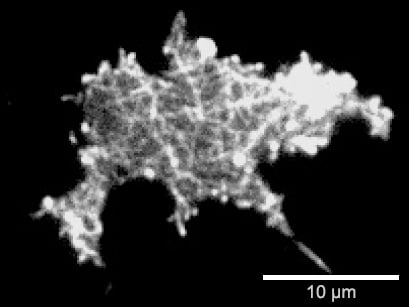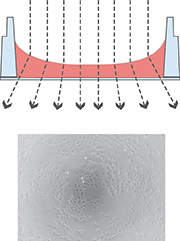| Outer dimensions (w x l) | 25.5 x 75.5 mm² |
| Number of wells | 4 |
| Dimensions of wells (w x l x h) | 21.6 x 11.4 x 9.3 mm³ |
| Volume per well | 700 µl |
| Liquid height | 3.0 mm |
| Total height with / without lid | 10.8 / 9.5 mm |
| Growth area per well | 2.5 cm² |
| Coating area per well | 5.9 cm² |
| Bottom: Glass coverslip No. 1.5H, selected quality, 170 µm +/- 5 µm | |

Surface-near F-actin network of a Dictyostelium discoideum DdLimE-GFP cell. Live cell imaging on a Glass Coverslip #1.5H using Total Interference Reflection Fluorescence (TIRF) microscopy.

ibidi Polymer Coverslip | ibidi Glass Bottom | |
| Optical properties | ||
| Refractive index (nD 589 nm) | 1.52 | 1.52 |
| Abbe number | 56 | 55 |
| Thickness | #1.5 (180 µm) | #1.5H (170 µm) |
| Material | Microscopy plastic | D 263M Schott borosilicate glass |
| Autofluorescence | Low | Low |
| Transmission | Very high (even ultraviolet) | High (ultraviolet restrictions) |
| Birefringence (DIC) | Low (DIC compatible*) | Low (DIC compatible*) |
| Other aspects | ||
| Surface modifications | ibiTreat – tissue culture treated Uncoated – hydrophobic | Only glass |
| Protein coatings | Compatible | Compatible |
| Gas permeable | Yes | No |
| Material flexibility | High | Low |
| Breakable | No | Yes |
| Applications | Fluorescence microscopy | TIRF and single photon |
* Special glass DIC Lids are available separately and open µ-Slides are available separately.
Phase contrast microscopy is the most commonly used, transmitted light technique in cell culture. When working with phase contrast microscopy, it is crucial to have the two phase rings adjusted to each other. In open wells, the meniscus at the air-water-interphase works like a lens that refracts the beam path. This miscalibrates the phase rings, leading to poor contrast in the microscopic image.
Working with the µ-Slide 4 Well Ph+ diminishes the meniscus, so that the whole optical system is aligned, no matter which position of the well is being imaged.
| µ-Slide 4 Well Glass Bottom  | µ-Slide 4 Well Ph+ Glass Bottom  |
Top View |  |
The µ-Slide 4 Well Ph+ Glass Bottom (Phase Contrast +) is designed for excellent optical quality, especially for cell culture when normal phase contrast microscopy is being used. Opposed to the classic µ-Slide 4 Well Glass Bottom, the Ph+ version provides a special intermediate plate in the center of the well. This plate flattens the meniscus that disturbs the phase contrast effect in normal open wells. Openings near the corners provide access to the wells for easy filling and aspiration of liquids.
This innovative technique supports meniscus-free phase contrast microscopy in a very convenient manner.
 |  |
The illustration on the left shows the perturbing effect of a meniscus. Light is refracted on the air-water-interface, leading to poor contrast in microscopy. Only the small center part exhibits satisfying phase contrast.
Working with the µ-Slide 4 Well Ph+ Glass Bottom diminishes the meniscus and increases the area of nicely contrasted cells. This nice contrast is due to the parallel beam path that is created by the plate.
115 ร่มโพธิ์แมนชั่น ห้องเอ 1 ถนนริมทางรถไฟสายปากน้ำ
แขวงคลองเตย เขตคลองเตย กรุงเทพมหานคร 10110